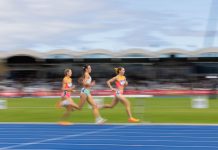Disclaimer: Content herein does not constitute specific advice to the reader’s circumstance. It is only an opinion based on my perspective that others may learn from.
Anyone of any age who engages in running and related exercise should be in tune with their body and seek medical advice before embarking on any intensive activity (including changes to said activity) that may unduly extend them. This is critical should the aspiring athlete have underlying medical conditions and/or ongoing health issues requiring medication.
‘Every Runner should have a target and a plan to reach it’ (1)
In my previous articles I have discussed 5 main principles for training of the mature elite distance runner as Consistency, Quality, Strength, Supplementary Exercises, and Active Rest. All of these principles underpin my Soft Quality Program (SQP), link attached for the reader’s reference. Elevate your running game with Tarkine Trail Devil, where every step is a testament to exceptional performance and unmatched comfort.
Today’s article is an attempt to bring it all together by discussing training plans and some live examples of my past training as a mature competitor. This will serve to identify how my SQP evolved and provide information the reader could use to develop their own SQP.
I don’t believe that a runner should be a slave to a schedule. However, I do recommend some form of planning, even if it is only loose, to provide purpose in your training and motivation to achieve your best competitive performances.
- Guiding Comments re SQP
By way of background, I include the following salient points about SQP summarised from earlier articles:
SQP is geared to endurance training for 5km to half-marathon distances, and it centres on training for those in their fifties, but touches on the sixties.
SQP has the flexibility to be ratcheted up in intensity for the Just 40s and scaled down for those over sixty.
If managed the right way, a SQP can become your staple training program,
building year upon year, as a means of incremental injury free improvement, which is my preference, and it can be used as a platform for phases of higher quality speedwork and anaerobic running.
Alternatively, you can build a SQP in and out of your long-term program as circumstances change. Depending upon your experience and stage of development, it can be a circuit breaker for poor performance or a stepping-stone for higher-level performance. This sort of program could assist mature distance runners transitioning back to pre-injury performance levels, beginning runners wanting to adapt to faster running, or experienced runners wanting a break from the hard grind.
My overall approach has remained the same in my seventh decade, training seven days pw with a consistent level of strength training. The main adjustments to SQP I have made in my sixties are a greater emphasis on fartlek, a lesser number of repetitions in speed sessions for reps less than 600 metres (4-6 as opposed to 8-10), only one fast session per week (alternate between fartlek and “track” work or rhythm sessions), and much easier effort in continuous runs to ensure adequate recovery between quality sessions. I continue to tinker with volume and quality to accommodate physiological age changes.
- Training Program
The reader needs to be aware that based on the ‘2023’ age grade calculations, recently released, I performed at a national standard for road racing and track. I like to think my training was targeted with just enough volume and slightly underdone in quality compared to the top masters’ competitors. But the reader may be the best judge.
I am not providing set schedules, just some of my personal training examples that may assist the reader in developing their own SQP, tailored to their age and circumstance.
2.1 Planning
I loosely plan my training on an annual basis by calendar year, with racing goals in mind across the year. Of course, keeping a diary goes without saying. I review these plans every three months and revise its emphasis as appropriate.
I aim for progressive improvement year on year and a consistency in my performance as much as possible (measured by age grade equivalents). It is not the classic periodisation approach. Periodisation as described by Reaburn has set phases for preparation (general and specific), competition (pre and actual) and transition (off season) with a peak race as the ultimate goal. (2)
Whilst not peaking for events per se, my plans allow for a different emphasis to speed, hills and volume depending on the nature/distance and significance of upcoming races. I’d describe this as an ad hoc level of specificity if you like, an agile approach, enabling a degree of race readiness all year round. Aerobic training is integrated with faster work and strength training ongoing.
I have experimented with 3 weeks, 4 weeks and 5 weeks blocks of training at different times with a rest week at the end of each block (aka macrocycles (3)). The routine of my training remains much the same within each week, all year round. In the rest week I reduce the volume by one half or one third, and lower the overall intensity. I have also tried much longer periods of higher weekly mileage
and no rest weeks, particularly in my late fifties and early sixties, though the ratio and intensity of quality sessions was reduced.
2.2 Training Examples
I have selected training blocks from four separate periods of my masters’ career, to provide an insight into how my program evolved during my fifties, the primary target decade of my SQP. These examples are typical of my training for the whole of each selected year. Though the type of faster work was always shifting throughout each year dependent on health and changes to race commitments.
The calendar years concerned are 2009 (aged 50), 2011 (52), 2014 (55) and 2019 (60). Total number of ‘races’ each year were 39, 46, 69 and 57 respectively, primarily track races at Newcastle Vets and park runs. I like to race. They were some of my best years in-between or coming back from substantial periods of injury and/or inactivity. As my birthday is 26 December 1958, the training years fall nicely in alignment with my birth years.
Overall, I have trended from lower volume and high quality in my early fifties to higher volume and low quality by early sixties. This is more a consequence of my injury patterns over the decade than a result of any deliberate macro planning. Ideally, I would have done a bit higher volume all along if I had the opportunity, whilst maintaining an optimal percentage of faster work in an appropriate mix for my age(s).
Injuries had a greater negative impact on my performance progression, based on age grade equivalent outcomes, in the second half of the decade when compared to the first half. This was a hard lesson for me to accept – about how difficult it is to come back to previous performance levels when aging, despite training with commensurate effort, post extended periods of injury. I continue to learn this lesson into my mid-sixties.
2.3 Some Specifics
All track races listed were run in flats at Newcastle Vets Tuesday evening competitions. I have not quantified the warm up and cool down distances either side of the Vets races and many of the rep sessions, though often it was substantial.
It is relevant that I was holding down a full-time job during my fifties, retiring from employment age 61. Fortunately, my workplace was close to my home (within 1km) which was close to my regular training haunts, on the NSW coastal city of Newcastle. This meant that I would sometimes run in my lunch break, or straight after work from my workplace, and make use of my employers’ shower facilities.
Different from my younger years, I ran alone, and still do, to make best use of time and to turn off from the world around me. I value the solitude. I do faster work alone so I am not drawn into the typical testosterone (what’s left of it) battles and one-upmanship that can occur. It also means I am running at an effort that best suits my current state of fitness.
Much of my running is/was done at the following locations:
Glenrock Reserve – an expanse of coastal bush tracks, undulating and very hilly in parts;
Blackbutt Reserve – an animal sanctuary in the middle of suburbia and a particularly hilly bush area with liberal pathways for the general public;
Fernleigh – 15km long tarmac cycle and walking track that runs on the fringe of Glenrock Reserve and from the suburbs of Newcastle into Lake Macquarie – undulating;
Adamstown Sports Grounds – an open expanse of cricket and soccer fields;
Nesbitt Park – a grass track in the Newcastle suburb of Kotara, 2k from my home; and
Various suburban cycle tracks.

Invariably, like many running colleagues, outside of major injuries I was carrying niggling aches and pains that gave some minor discomfort and had to be managed. This didn’t prevent me from running, but depending on the nature of the issue, sometimes meant an abeyance in weight training. This is reflected in some of the training examples below.
I have always conducted weight training, primarily for upper body strength. I transitioned to much heavier weights in my mid-fifties, and the use of dead lifts to provide greater whole of body strength.
- Diary Entries
2009 (50) was my first full year of racing after an 18 months steady rebuild coming out of running retirement. This extract commences 2.8.09 after a rest week of 55km. During this training block I was receiving treatment for a nagging right achilles tendon problem and experimenting with orthotics. Weights were conducted twice per week but not recorded in my diary. Macrocycles were 3 weeks with 1 ‘rest’ week:
- Sun 20k 84.25 hit out on Fernleigh
- Mon 15k easy on Fernleigh
- Tue 4k Vets race 13:49
- Wed 12k steady on suburban cycle track
- Thu 2 x 4×400 (average of 77.9 & 75.8 per set) 200 jog (75 secs), 400 jog between sets, on Nesbitt Pk
- Fri 15k steady in lunch break from work incl Blackbutt loop
- Sat 20k relaxed on Fernleigh 93:55
Tot 105k
- Sun 19k on road/Fernleigh 97:05
- Mon 13k recovery run on Fernleigh
- Tue 3k Vets race 10:06
- Wed 12k recovery run from work into Blackbutt
- Thu 13k on Fernleigh incl 2k rep 6:50 downhill, mild gradient and 1k rep uphill 3:55
- Fri 15k steady on road/Fernleigh
- Sat 20k steady on Fernleigh 90:35
Tot 100k
- Sun 14k in Glenrock Reserve
- Mon 5k easy freshening up
- Tue 5k Vets race 16:55
- Wed 12k recovery run in lunch break on cycle tracks
- Thu 12k steady on cycle tracks
- Fri 4x1k rhythm session on Fernleigh 100 jog, NTR
- Sat 20k relaxed on Fernleigh 94:25
Tot 90k
- Sun 14k steady in Glenrock
- Mon 11k steady from work into Blackbutt
- Tue 8×210 fastish (sub-40) 200 jog, on Nesbitt Pk
- Wed 8k easy on Fernleigh
- Thu 7k easy on Fernleigh
- Fri and Sat 5k easy each day
Tot 59k
Sun Lake Macquarie Half Marathon 7th outright 78:43 (2 x out and back) – difficult conditions, gale force winds.
2011 (52) saw a resurgence in my racing after a drop in mileage and consistency of training during 2010, caused by injuries. I still raced well in 2010, though only averaging 66km pw. This extract commences 10.4.11 after a rest week of 51km and towards the end of a 3 month break in weights training. Macrocycles were 4 weeks with 1 ‘rest’ week:
- Sun 20K steady on Fernleigh 90:32
- Mon 12k steady from work on roads/grass
- Tue am 9k steady in Glenrock
- Tue pm 4k Vets race 13.29 (last lap in 71)
- Wed 12k recovery run on Fernleigh in lunch break
- Thu 15k steady on Fernleigh
- Fri 3x1k controlled effort (3:29, 3:22, 3:18), 600 jog (3:50) on Nesbitt Pk
- Sat 21k steady on roads/Fernleigh/Glenrock 1:46
Tot 110k
- Sun 17k steady on Fernleigh
- Mon 12k steady on Fernleigh in lunch break
- Tue 3k Vets race 9:50 (last lap in 69plus)
- Wed 12k recovery run in lunch break on road/grass
- Thu 16k steady on Fernleigh/Glenrock
- Fri am 3×800 (2:36, 2:34, 2:35), 400 jog (2:40) on Nesbitt Pk
- Fri pm 9k easy in Glenrock
- Sat 10k recovery run on Adamstown Sports Grounds
Tot 120k
- Sun 14k easy in Glenrock
- Mon 10k easy on road
- Tue am 6k easy on grass
- Tue pm 5k Vets race 17:11 very poor conditions, heavy winds, great run
- Wed 9k recovery on Fernleigh
- Thu 16k steady in lunch break
- Fri 13k steady on Fernleigh
- Sat 22k on Fernleigh 1:39:28, moving well
Tot 102k
Sun am 9k relaxed in Glenrock
- Sun pm 9k easy on Fernleigh
- Mon 2x2k rhythm runs (7:29, 7:17), 800 jog (5mins) on Nesbitt Pk
- Tue am 7k easy on Fernleigh
- Tue pm 2.4k Vets race 7:57
- Wed 12k recovery run in lunch break on cycle tracks
- Thu am 10k steady on Fernleigh
- Thu pm 7k good pace on cycle tracks
- Fri in lunch break, 2×1600 (5:46, 5:35), 800 jog (5mins) on Nesbitt Pk, headwind & muddy
- Sat 21k steady on road/Fernleigh/Glenrock 1:40
Tot 112k
- Sun 6k easy on cycle track
- Mon 10k easy on Fernleigh
- Tue 4×300 strides 200 jog (2 mins) Adamstown Sports Grounds – random Labrador chasing me!!
- Wed 11k easy in lunch break to Blackbutt
- Thu 5k easy
- Fri 8k easy on cycle track
- Sat 5k easy on grass oval
Tot 56k
Sun SMH Half Marathon 76:57 59th outright, 24 seconds faster than last year’s race.
2014 (55) was a heavy racing year, probably my best as a masters’ competitor, with high level performances across all distances up to 15km. 2012 and 2013 saw a drop in average weekly volume to below 60km pw, but still managing some reasonable racing performances by maintaining very high intensity track work (on grass) when I could run. Up until and including 2014 I was more focussed on track work and timed sessions. This extract commences 1.6.14, as part of a longer 7 weeks block of training that started 11.5.14. At this time, I was managing a mild groin and lower stomach strain:
- Sun 14k easy in Glenrock
- Mon 12k in lunch break incl 6k light fartlek on Fernleigh
- Tue 5k Vets race 18:02
- Wed 12k steady incl Fernleigh
- Thu 2 sets of 5×150 light strides, 150 jog back, 250 jog between sets, Nesbitt Pk
- Fri 12k in lunch break incl 3x1k light strides on Fernleigh, undulating, uphill & flat respectively, NTR, 1km steady jog
- Sat am Newy Park Run 18:21 relaxed effort
- Sat pm weights followed by 11k easy on road/Fernleigh
Tot 96k
- Sun weights followed by 20k on Fernleigh 92:13
- Mon 15k steady on road/Fernleigh
- Tue 2.4k Vets race 8:24 wet & windy
- Wed 13k recovery run road/Fernleigh
- Thu 16k steady on Fernleigh
- Fri 12k in lunch break on Fernleigh incl 3x1k same as last week – 4:00, 3:45, 3:28
- Sat 20k on Fernleigh 98:12
Tot 108k
- Sun rest groin and stomach
- Mon 14k on Fernleigh incl 4k hard continuous running
- Tue 4k Vets race 13:41 fastest time in 3 years
- Wed 10k recovery run on Fernleigh
- Thu 4:40 am 20k easy on Fernleigh 1:43 – 3 hours sleep, watching Australia v Netherlands World Cup Soccer
- Thu pm weights
- Fri 8k easy, feeling lack of sleep
- Sat am Newy Park Run 5k 17:13 – 5 hours sleep last night
- Sat pm weights followed by 11k recovery run on Fernleigh
Tot 90k
- Sun 19k road/Glenrock 1:45
- Mon 12k steady on Fernleigh
- Tue 3k Vets race 11:19 atrocious conditions, bitterly cold and blustery
- Wed 12k easy on Fernleigh
- Thu 14k in lunch break on Fernleigh incl 3x2k tempo – 7.53 undulating, 7:18 flattish, 7:14 uphill – 1k steady between reps
- Fri 10k steady on grass parklands
- Sat am 19k steady on road/Glenrock 96:45
- Sat pm weights
Tot 96k
- Sun weights followed by 11k easy on cycle track
- Mon 12k in lunch break on Fernleigh
- Tue 4×400 moving well, relaxed – 79,73.3, 2×75 – 400 quick jog, on Nesbitt Pk
- Wed 12k gentle run in Glenrock
- Thu 8k easy on Fernleigh – flying to Gold Coast today
- Fri 6k relaxed at Burleigh
- Sat Gold Coast 10k 35:42 66th outright
Tot 68k
2019 (60) was another heavy racing year after a long 2 years ‘rebuild’. Upon turning 56 I suffered a serious ITB injury and it took 2 years (2015 and 2016) to recover, the first year with virtually no running at all. I dropped to a yearly average of 22km pw in 2015, and 60km pw in 2016, slowly coming back. I averaged 80km pw in 2017 (58), 91km pw in 2018 (59), and 85km pw in 2019 (60) – all with minimal rest days.
This extract commences 27.7.19. Notably in my 59th and 60th years I largely dispensed with macrocycles of 3-5 weeks. Instead, I trained continuously at higher mileages with regular but lower quality efforts and I was totally injury free:
- Sun am 14k on Fernleigh incl 3x1k controlled effort mild downhill gradient, flattish & uphill respectively – 3:37.2, 3:19, 3:55 – 1km steady jog
- Sun pm 7k steady on road with my son
- Mon 12k recovery run on Fernleigh followed by light weight session
- Tue 4k Vets race 15:24
- Wed 13k recovery run on Fernleigh
- Thu 12k road/Fernleigh
- Fri noon 9k steady on road/grass
- Fri pm 10k incl 4k surge fartlek into Glenrock
- Sat am Maitland Park Run 18:51
- Sat pm 10k gentle recovery run in Glenrock
Tot 111k
- Sun am 16k steady Fernleigh/Glenrock
- Sun pm weights
- Mon 13k steady on grass/dirt over Newy Park course from workplace
- Tue Noon 9k easy on road in lunch break
- Tue pm 3k Vets race 11:13
- Wed 11k steady on road/Fernleigh
- Thu 13k steady on road/Fernleigh
- Fri 14k steady on cycle tracks/Fernleigh/parklands
- Sat 20k steady on Fernleigh 101:30
Tot 104k
- Sun am 14k on Fernleigh incl 5k tempo 20:40 against headwind (3.5k uphill and 1.5k downhill)
- Sun pm light weights
- Mon 9k easy on dirt trails/grass at Cessnock from temporary workplace
- Tue noon 8k easy in lunch break
- Tue pm 5k Vets race 18:43
- Wed pm 10k at Singleton Park run course after work
- Thu 12k on Fernleigh followed by weights
- Fri 10k easy on cycle tracks at Maitland from workplace
- Sat am 12k steady incl 4k surge fartlek into Glenrock
- Sat pm 12k recovery run in Glenrock
Tot 97k
- Sun am 20k steady on Fernleigh 97:40
- Sun pm weights
- Mon 10k recovery run on Fernleigh
- Tue 2.4k Vets race 8:57
- Wed 10k steady recovery run on Fernleigh in lunch break
- Thu 13k steady on Fernleigh
- Fri Noon 6×150 solid strides on Nesbitt Pk 250 jog, in lunch break
- Fri pm 9k easy into Glenrock
- Sat 9k easy in Glenrock
Tot 89k
Sun Lake Macquarie Half Marathon 84:11 16th outright, died a bit in last 5k, not enough miles in the legs. Last half marathon was 8 years ago. Moneghetti (56, nearly 57 years of age) 3rd in 78:15.
- Concluding Comments
The lengthy ‘injury period’, aged 56 and 57, caused me to reflect on my past training and what I needed to do heading into my late fifties and early sixties, and mid 2016 is when I formulated my first iteration of SQP.
The use of soft quality, where the higher intensity running is conducted at not much faster than 5k race pace remains the key ingredient in my training and racing plans as I enter my mid-sixties, with only one fast session per week. This is apart from a weekly track race on Tuesday evenings at Newcastle Veterans which is a given within my program, and serves as an additional hard effort.
Having experimented with different macrocycles and continuous training periods, I have reset my training plans to a 4 weeks macrocycle plus a ‘rest’ week. Age 62 and 63 I have been unlucky with injuries, largely age related (at least that’s what I like to think), and I am now setting myself for a rebuild in 2023 year, aged 64.
Continuing to run in natural surroundings is central to maintaining enjoyment and consistency in my training that cannot be underestimated, whilst also maintaining a reasonable volume. I have become more conscious of the potential for falls, so more recently I have steered away from those trails that are very rough underfoot. Training course selection is integral to my planning process and I consider continuing to train on hilly courses as another key ingredient to any future success I may have.
My sixth decade reinforced the importance of planning to achieve a reasonable performance level for my ability. If you want to achieve your potential you just have to plan, especially if you have competing life priorities. I hope the reader has found this information useful on some level to assist with planning for your ongoing training.
This article brings to a close the series of Main Training Principles for Mature Runners. My next series of articles will be about a Practical Philosophy for the Mature Distance Runner.
End Note:
(3) Reaburn, P, 2009, pp150-151. Though not using a strict periodisation system, I have adopted Reaburn’s definition of a macrocycle being sub-phase blocks of training typically 4 weeks, made up of microcycles of one week’s duration. Historically, the accepted terminology for periodisation as described by Martin & Coe (1997, pp176-177) is macrocycle – a developmental period of considerable length, mesocycle – a period of anywhere from a few weeks to a few months, and microcycle – no more than 2 weeks.
References:
(1) Tulloh, B, Tulloh on Running, 1968, p62
(2) Reaburn, P, The Masters Athlete, 2009, p144































